SUBARU BAJA 2005 1.G Owners Manual
Manufacturer: SUBARU, Model Year: 2005, Model line: BAJA, Model: SUBARU BAJA 2005 1.GPages: 469, PDF Size: 5.24 MB
Page 291 of 469
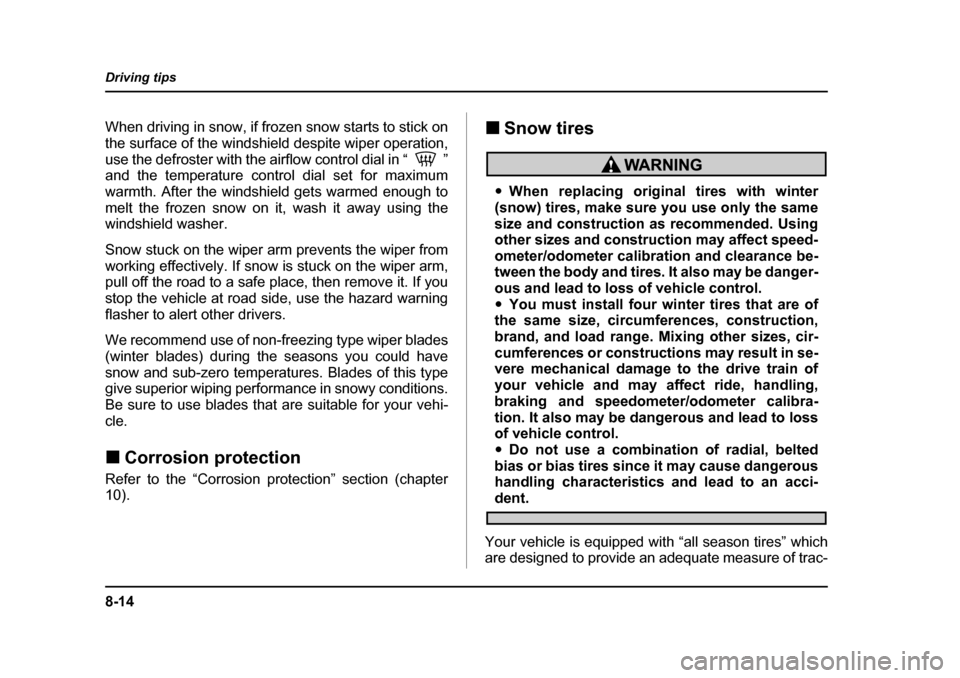
8-14
Driving tips
When driving in snow, if frozen snow starts to stick on
the surface of the windshield despite wiper operation,
use the defroster with the airflow control dial in “ ”
and the temperature control dial set for maximum
warmth. After the windshield gets warmed enough to
melt the frozen snow on it, wash it away using the
windshield washer.
Snow stuck on the wiper arm prevents the wiper from
working effectively. If snow is stuck on the wiper arm,
pull off the road to a safe place, then remove it. If you
stop the vehicle at road side, use the hazard warning
flasher to alert other drivers.
We recommend use of non-freezing type wiper blades
(winter blades) during the seasons you could have
snow and sub-zero temperatures. Blades of this type
give superior wiping performance in snowy conditions.
Be sure to use blades that are suitable for your vehi-cle. �„
Corrosion protection
Refer to the “Corrosion protection” section (chapter
10). �„
Snow tires
�yWhen replacing original tires with winter
(snow) tires, make sure you use only the same
size and construction as recommended. Using
other sizes and construction may affect speed-
ometer/odometer calibration and clearance be-
tween the body and tires. It also may be danger-
ous and lead to loss of vehicle control.�y You must install four winter tires that are of
the same size, circumferences, construction,
brand, and load range. Mixing other sizes, cir-
cumferences or constructions may result in se-
vere mechanical damage to the drive train of
your vehicle and may affect ride, handling,
braking and speedometer/odometer calibra-
tion. It also may be dangerous and lead to loss
of vehicle control. �y Do not use a combination of radial, belted
bias or bias tires since it may cause dangerous
handling characteristics and lead to an acci-
dent.
Your vehicle is equipped with “all season tires” which
are designed to provide an adequate measure of trac-
Page 292 of 469
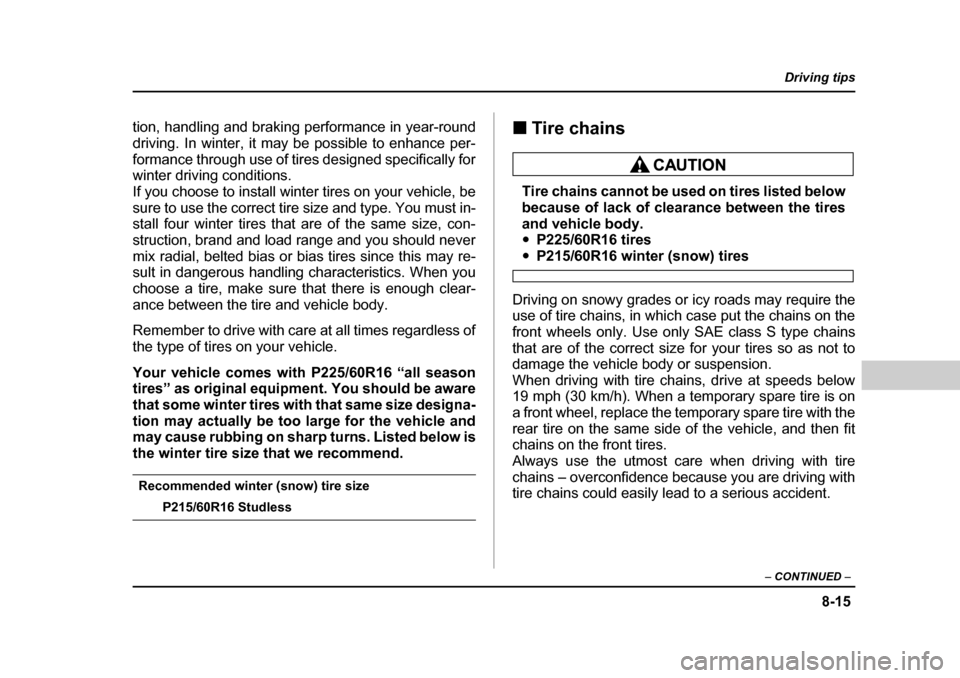
8-15
Driving tips
– CONTINUED –
tion, handling and braking performance in year-round
driving. In winter, it may be possible to enhance per-
formance through use of tires designed specifically for
winter driving conditions.
If you choose to install winter tires on your vehicle, be
sure to use the correct tire size and type. You must in-
stall four winter tires that are of the same size, con-
struction, brand and load range and you should never
mix radial, belted bias or bias tires since this may re-
sult in dangerous handling characteristics. When you
choose a tire, make sure that there is enough clear-
ance between the tire and vehicle body.
Remember to drive with care at all times regardless of
the type of tires on your vehicle.
Your vehicle comes with P225/60R16 “all season
tires” as original equipment. You should be aware
that some winter tires with that same size designa-
tion may actually be too large for the vehicle and
may cause rubbing on sharp turns. Listed below is
the winter tire size that we recommend.
Recommended winter (snow) tire size
P215/60R16 Studless �„
Tire chains
Tire chains cannot be used on tires listed below
because of lack of clearance between the tires
and vehicle body. �yP225/60R16 tires
�yP215/60R16 winter (snow) tires
Driving on snowy grades or icy roads may require the
use of tire chains, in which case put the chains on the
front wheels only. Use only SAE class S type chains
that are of the correct size for your tires so as not to
damage the vehicle body or suspension.
When driving with tire chains, drive at speeds below
19 mph (30 km/h). When a temporary spare tire is on
a front wheel, replace the temporary spare tire with the
rear tire on the same side of the vehicle, and then fit
chains on the front tires.
Always use the utmost care when driving with tire
chains – overconfidence because you are driving with
tire chains could easily lead to a serious accident.
Page 293 of 469
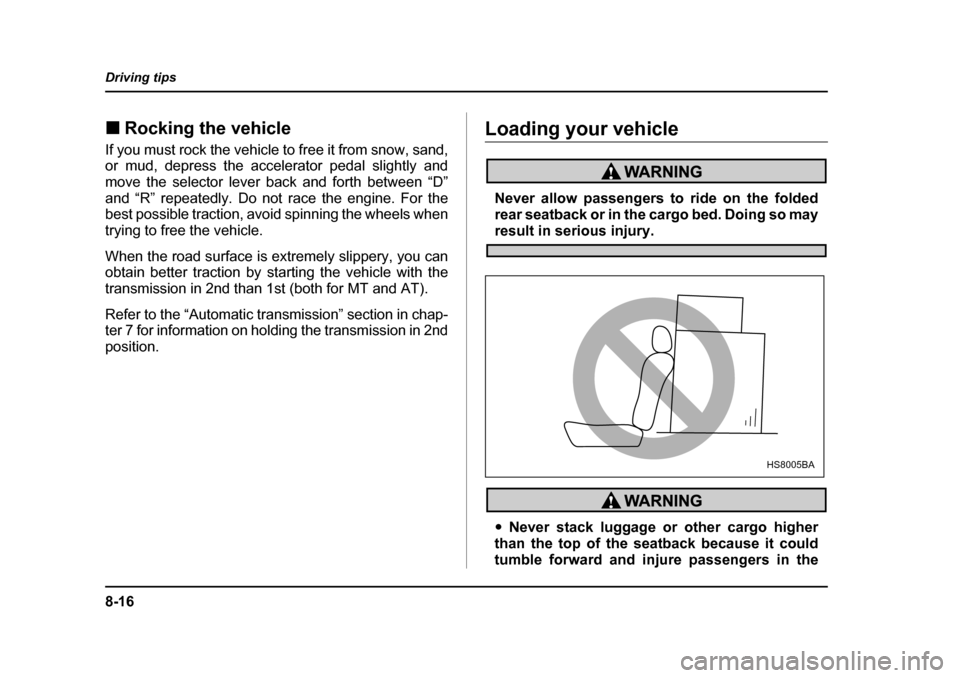
8-16
Driving tips
�„
Rocking the vehicle
If you must rock the vehicle to free it from snow, sand,
or mud, depress the accelerator pedal slightly and
move the selector lever back and forth between “D”
and “R” repeatedly. Do not race the engine. For the
best possible traction, avoid spinning the wheels when
trying to free the vehicle.
When the road surface is extremely slippery, you can
obtain better traction by starting the vehicle with the
transmission in 2nd than 1st (both for MT and AT).
Refer to the “Automatic transmission” section in chap-
ter 7 for information on holding the transmission in 2nd
position.Loading your vehicle
Never allow passengers to ride on the folded
rear seatback or in the cargo bed. Doing so may
result in serious injury.
�y Never stack luggage or other cargo higher
than the top of the seatback because it could
tumble forward and injure passengers in the
HS8005BA
Page 294 of 469
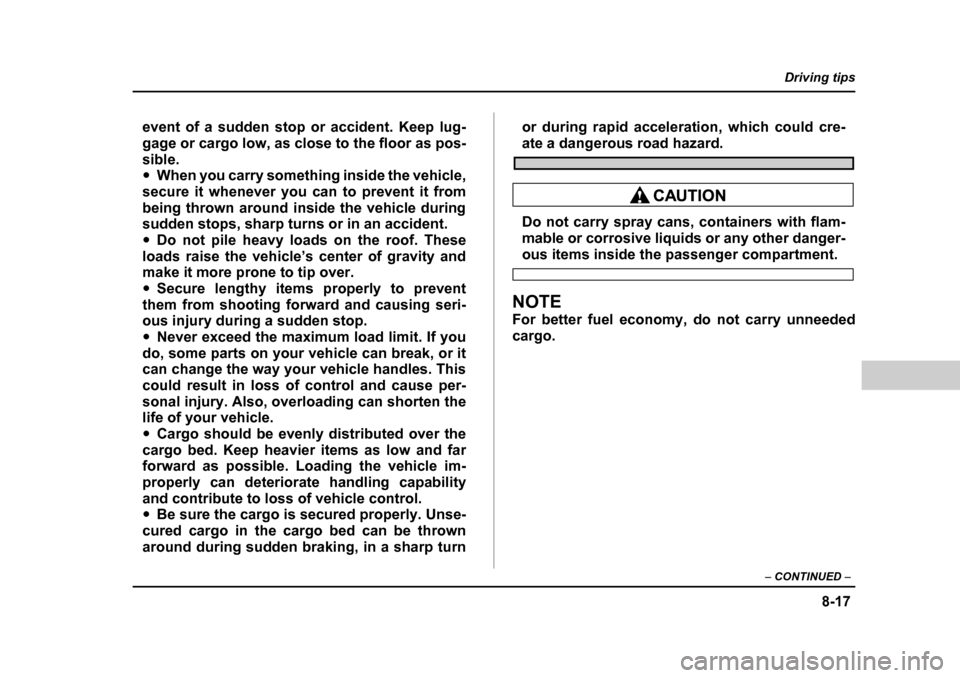
8-17
Driving tips
– CONTINUED –
event of a sudden stop or accident. Keep lug-
gage or cargo low, as close to the floor as pos-
sible. �yWhen you carry something inside the vehicle,
secure it whenever you can to prevent it from
being thrown around inside the vehicle during
sudden stops, sharp turns or in an accident. �y Do not pile heavy loads on the roof. These
loads raise the vehicle’s center of gravity and
make it more prone to tip over. �y Secure lengthy items properly to prevent
them from shooting forward and causing seri-
ous injury during a sudden stop. �y Never exceed the maximum load limit. If you
do, some parts on your vehicle can break, or it
can change the way your vehicle handles. This
could result in loss of control and cause per-
sonal injury. Also, overloading can shorten the
life of your vehicle. �y Cargo should be evenly distributed over the
cargo bed. Keep heavier items as low and far
forward as possible. Loading the vehicle im-
properly can deteriorate handling capability
and contribute to loss of vehicle control. �y Be sure the cargo is secured properly. Unse-
cured cargo in the cargo bed can be thrown
around during sudden braking, in a sharp turn or during rapid acceleration, which could cre-
ate a dangerous road hazard.
Do not carry spray cans, containers with flam-
mable or corrosive liquids or any other danger-
ous items inside the passenger compartment.
NOTE
For better fuel economy, do not carry unneeded
cargo.
Page 295 of 469
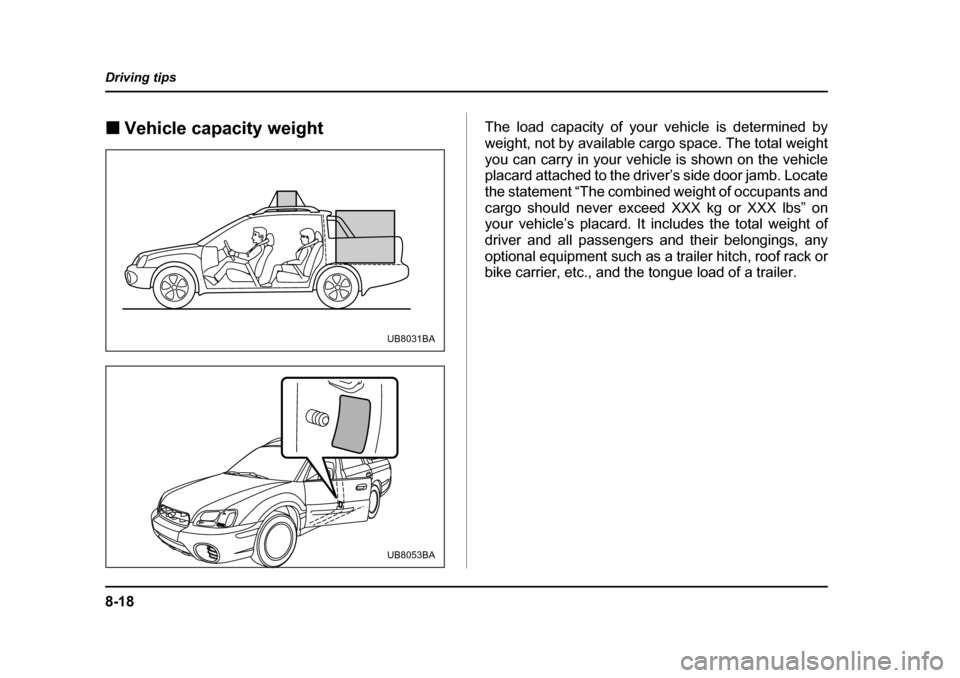
8-18
Driving tips
�„
Vehicle capacity weight The load capacity of your vehicle is determined by
weight, not by available cargo space. The total weight
you can carry in your vehicle is shown on the vehicle
placard attached to the driver’s side door jamb. Locate
the statement “The combined weight of occupants and
cargo should never exceed XXX kg or XXX lbs” on
your vehicle’s placard. It includes the total weight of
driver and all passengers and their belongings, any
optional equipment such as a trailer hitch, roof rack or
bike carrier, etc., and the tongue load of a trailer.
UB8031BA
UB8053BA
Page 296 of 469
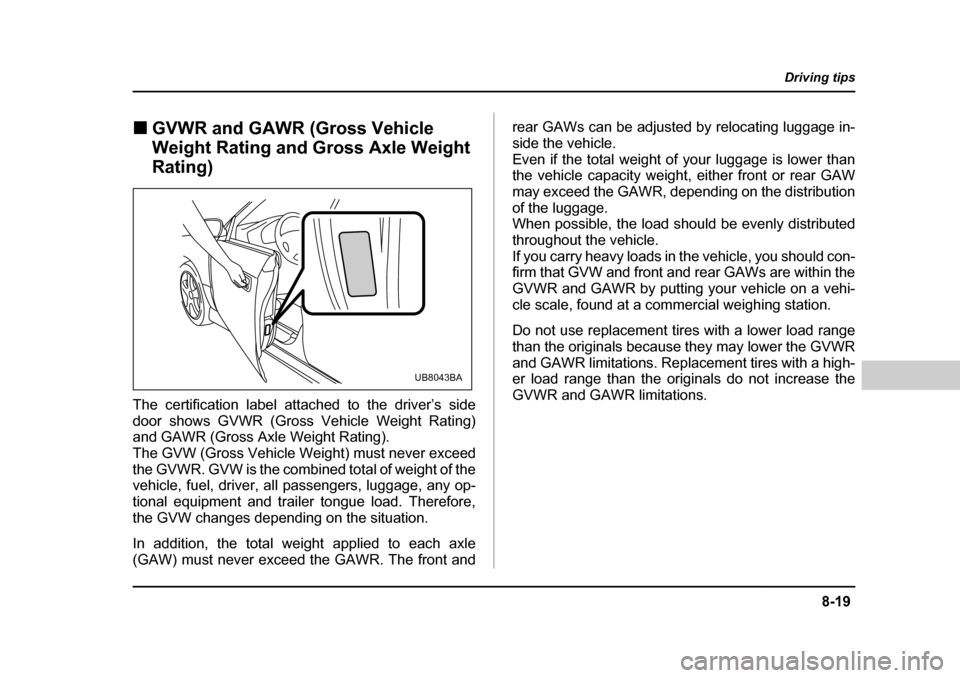
8-19
Driving tips
– CONTINUED –
�„GVWR and GAWR (Gross Vehicle
Weight Rating and Gross Axle Weight
Rating)
The certification label attached to the driver’s side
door shows GVWR (Gross Vehicle Weight Rating)
and GAWR (Gross Axle Weight Rating).
The GVW (Gross Vehicle Weight) must never exceed
the GVWR. GVW is the combined total of weight of the
vehicle, fuel, driver, all passengers, luggage, any op-
tional equipment and trailer tongue load. Therefore,
the GVW changes depending on the situation.
In addition, the total weight applied to each axle
(GAW) must never exceed the GAWR. The front and rear GAWs can be adjusted by relocating luggage in-
side the vehicle.
Even if the total weight of your luggage is lower than
the vehicle capacity weight, either front or rear GAW
may exceed the GAWR, depending on the distribution
of the luggage.
When possible, the load should be evenly distributed
throughout the vehicle.
If you carry heavy loads in the vehicle, you should con-
firm that GVW and front and rear GAWs are within the
GVWR and GAWR by putting your vehicle on a vehi-
cle scale, found at a commercial weighing station.
Do not use replacement tires with a lower load range
than the originals because they may lower the GVWR
and GAWR limitations. Replacement tires with a high-
er load range than the originals do not increase the
GVWR and GAWR limitations.
UB8043BA
Page 297 of 469
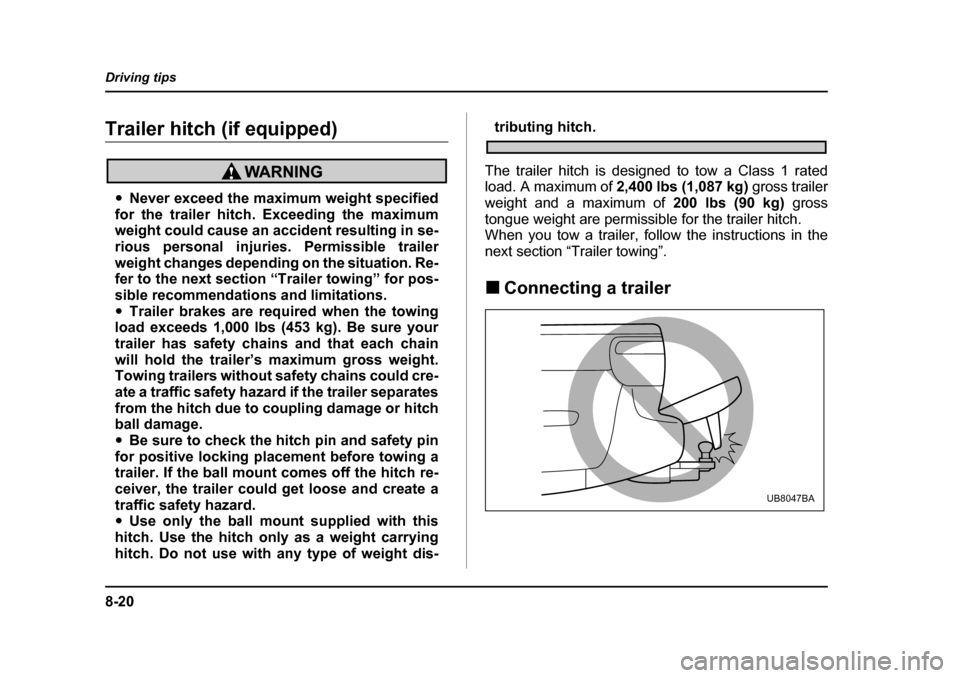
8-20
Driving tips
Trailer hitch (if equipped)
�y
Never exceed the maximum weight specified
for the trailer hitch. Exceeding the maximum
weight could cause an accident resulting in se-
rious personal injuries. Permissible trailer
weight changes depending on the situation. Re-
fer to the next section “Trailer towing” for pos-
sible recommendations and limitations. �y Trailer brakes are required when the towing
load exceeds 1,000 lbs (453 kg). Be sure your
trailer has safety chains and that each chain
will hold the trailer’s maximum gross weight.
Towing trailers without safety chains could cre-
ate a traffic safety hazard if the trailer separates
from the hitch due to coupling damage or hitch
ball damage. �y Be sure to check the hitch pin and safety pin
for positive locking placement before towing a
trailer. If the ball mount comes off the hitch re-
ceiver, the trailer could get loose and create a
traffic safety hazard.�y Use only the ball mount supplied with this
hitch. Use the hitch only as a weight carrying
hitch. Do not use with any type of weight dis-
tributing hitch.
The trailer hitch is designed to tow a Class 1 rated
load. A maximum of 2,400 lbs (1,087 kg) gross trailer
weight and a maximum of 200 lbs (90 kg) gross
tongue weight are permissible for the trailer hitch.
When you tow a trailer, follow the instructions in the
next section “Trailer towing”. �„ Connecting a trailer
UB8047BA
Page 298 of 469
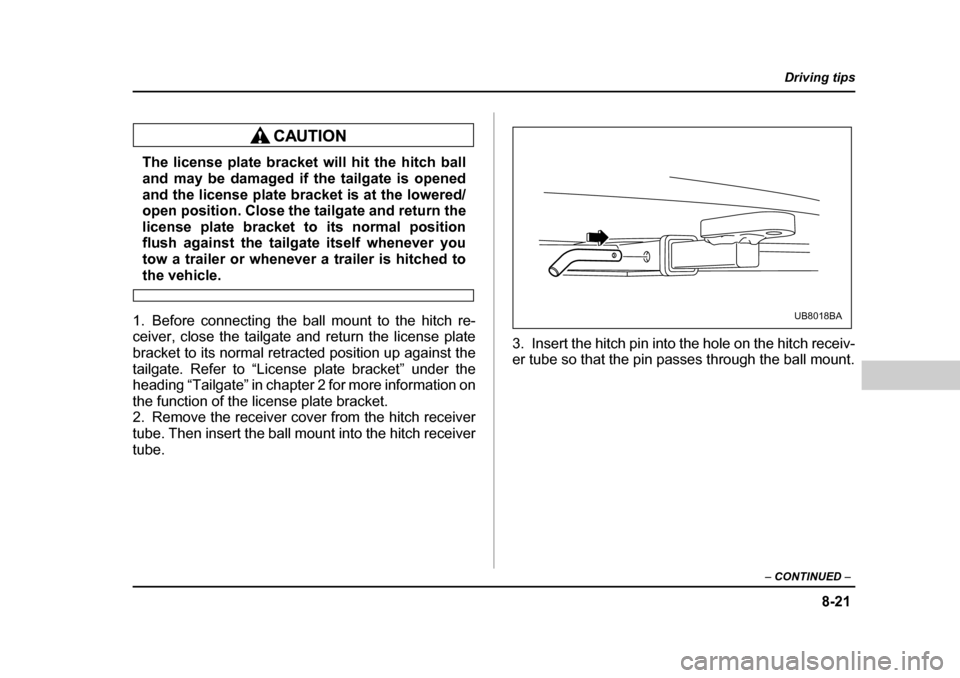
8-21
Driving tips
– CONTINUED –
The license plate bracket will hit the hitch ball
and may be damaged if the tailgate is opened
and the license plate bracket is at the lowered/ open position. Close the tailgate and return the
license plate bracket to its normal position
flush against the tailgate itself whenever you
tow a trailer or whenever a trailer is hitched to
the vehicle.
1. Before connecting the ball mount to the hitch re-
ceiver, close the tailgate and return the license plate
bracket to its normal retracted position up against the
tailgate. Refer to “License plate bracket” under the
heading “Tailgate” in chapter 2 for more information on
the function of the license plate bracket.
2. Remove the receiver cover from the hitch receiver
tube. Then insert the ball mount into the hitch receivertube. 3. Insert the hitch pin into the hole on the hitch receiv-
er tube so that the pin passes through the ball mount.
UB8018BA
Page 299 of 469
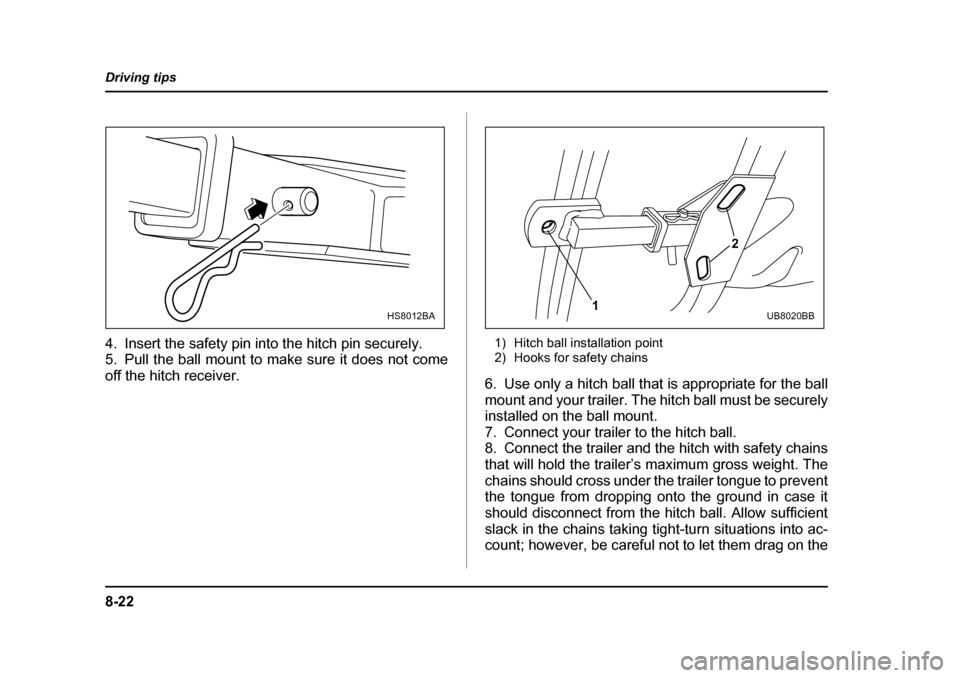
8-22
Driving tips
4. Insert the safety pin into the hitch pin securely.
5. Pull the ball mount to make sure it does not come
off the hitch receiver.
1) Hitch ball installation point
2) Hooks for safety chains
6. Use only a hitch ball that is appropriate for the ball
mount and your trailer. The hitch ball must be securely
installed on the ball mount.
7. Connect your trailer to the hitch ball.
8. Connect the trailer and the hitch with safety chains
that will hold the trailer’s maximum gross weight. The
chains should cross under the trailer tongue to prevent
the tongue from dropping onto the ground in case it
should disconnect from the hitch ball. Allow sufficient
slack in the chains taking tight-turn situations into ac-
count; however, be careful not to let them drag on the
HS8012BA1 2UB8020BB
Page 300 of 469
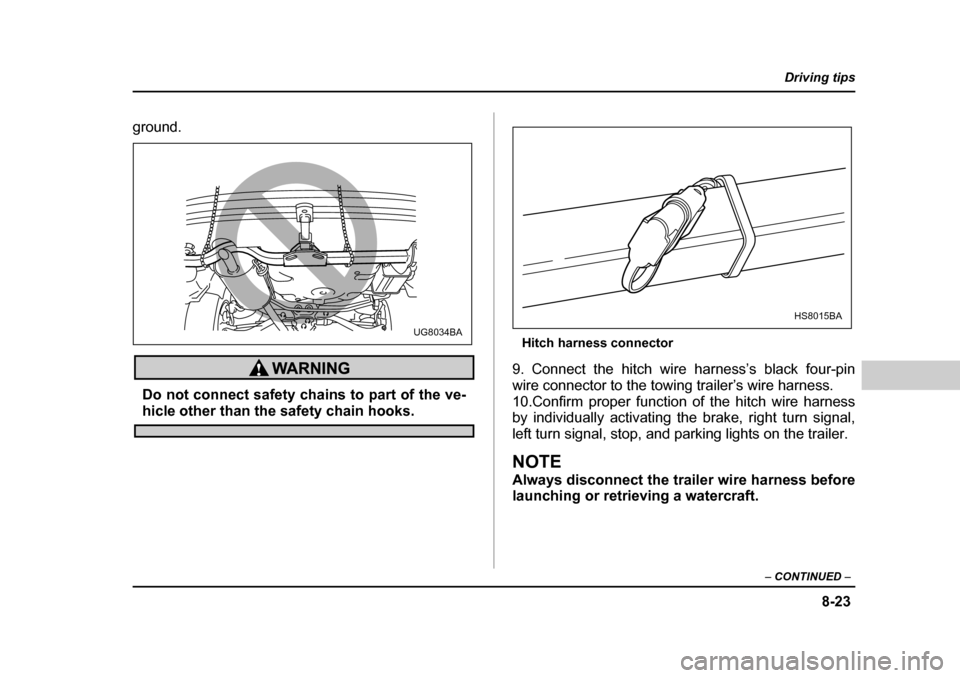
8-23
Driving tips
– CONTINUED –
ground.
Do not connect safety chains to part of the ve-
hicle other than the safety chain hooks. Hitch harness connector
9. Connect the hitch wire harness’s black four-pin
wire connector to the towing trailer’s wire harness.
10.Confirm proper function of the hitch wire harness
by individually activating the brake, right turn signal,
left turn signal, stop, and parking lights on the trailer.
NOTE
Always disconnect the trailer wire harness before
launching or retrieving a watercraft.
UG8034BA
HS8015BA